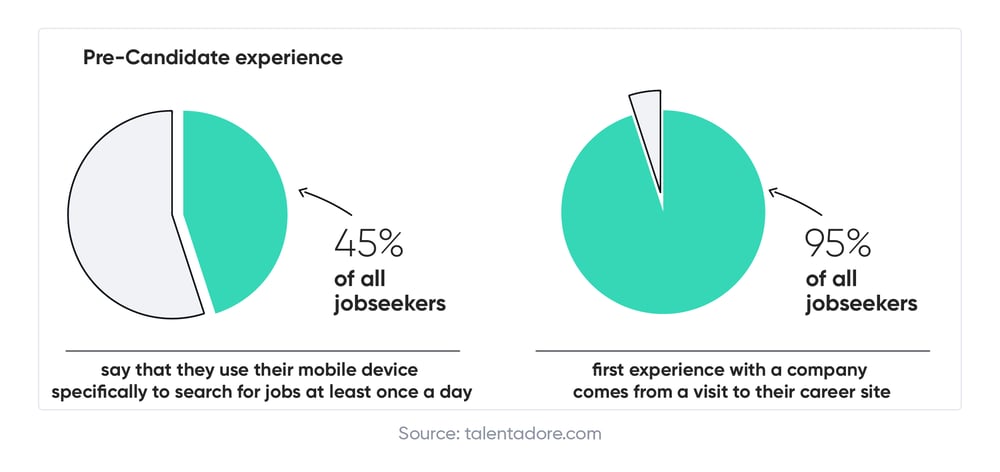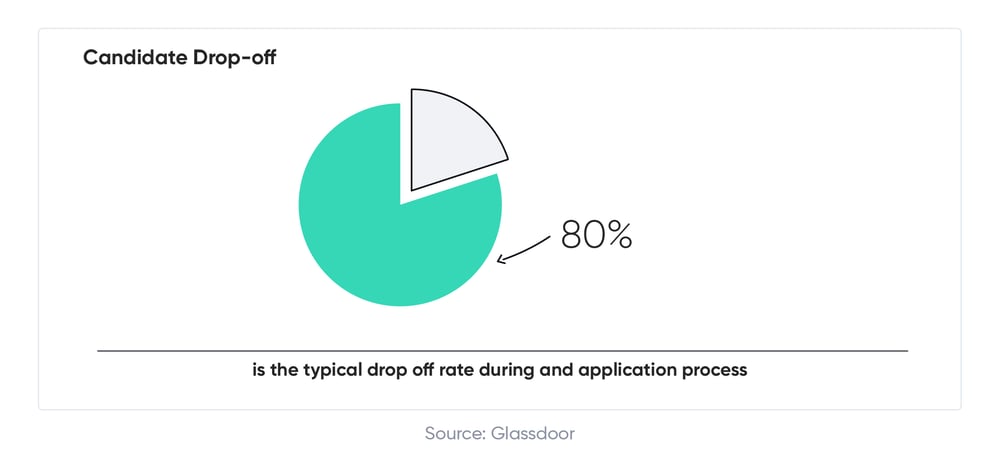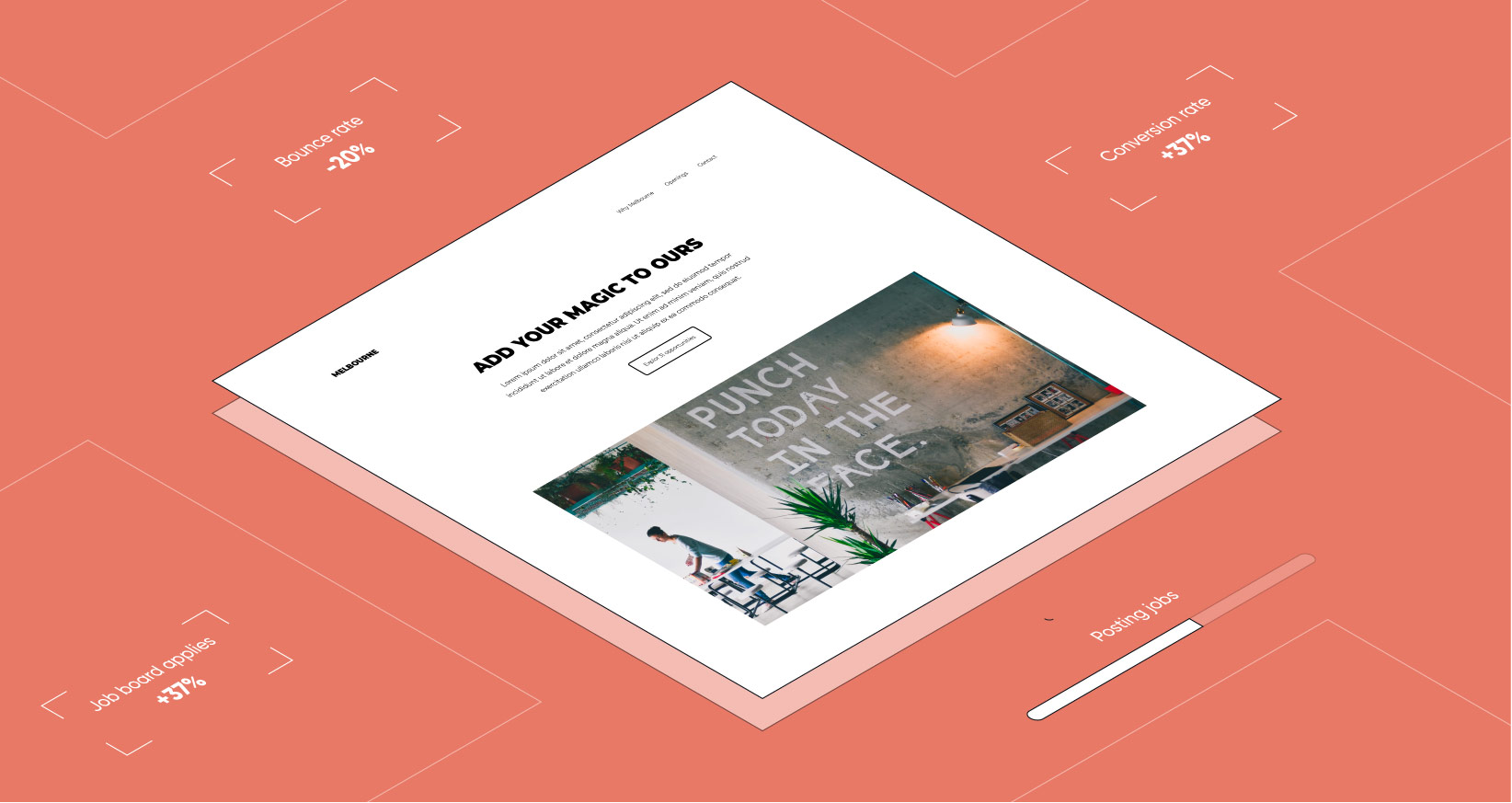Candidate experience has always been a primary concern for HR and recruitment marketing. That said, the current candidate-centered job market has pushed it even further into the spotlight. If a candidate doesn’t have a good experience working with you, or if your online presence doesn’t resonate with them, they’ll just walk next door to your competitor.
That means you stand to lose not only that great, high-quality candidate but also any future referrals they might have brought along, as well as the stellar reviews they could have left on Glassdoor, etc. Of course, in today’s data-driven recruiting world, there are metrics you can keep an eye on to gauge how your candidate’s experiences are going.
1: Pre-Candidate Experience
Since we’re talking about RM candidates, many of them probably started out as passive job hunters who were lured in by your stellar content and witty, engaging social media presence. This means there's a good chance they're reaching your via their mobile device. After all, 45% of all job seekers say that they use their mobile device specifically to search for jobs at least once a day. Conversely, they might be encountering your brand for the first time on your career page—which is true of 95% of job seekers according to Hodes). That’s why it’s a great idea to find out what exactly led them to you and, whatever the answer, do a pulse check to see just what is working so well, what might need some tweaking, and what you should consider dumping from active campaigns.

The easiest and more accurate way to get that pulse check is to use a short survey, given to new hires during onboarding, for example. Maybe 5 questions is enough to find out what drew them in, were they, in fact, passive, what aspects of your content strategy resonated with them, and so on. Don’t leave out a question about what might have missed the mark, too. That’s how you learn and shift your energy to other things.
2: Candidate Drop-off
Like it or not, candidate drop-off is a fact of life. According to Glassdoor, the typical drop-off rate for modern day applicants is 80%. The problem here can be 2-fold. First, the application process may be too long and/or confusing leading to a person just closing the browser tab and not finishing the process. Or alternatively, a candidate may have submitted a complete application, then been ignored for weeks on end. Either way, this leads to candidate drop-off.
The statistics to look at are bounce rate from your application pages, orphaned applications in your ATS, and to keep an eye on negative reviews for any that talk about the process being convoluted. Your ATS in particular can become a major stumbling block. Potentialpark found that 48% of applicants drop out due to complicated ATS-powered applications (which might explain why applicants expect to spend about 40 minutes filling out an online application). As dire as this may sound, there are solutions:

• Provide a progress bar so applicants can see how much they have left to complete.
• Provide a clear timeline as soon as a completed application is received.
• Follow up within a decent time frame, say a week, to let applicants know where they stand.
• If you find an orphaned application, follow up with the candidate to find out what happened.
3: Days-to-Acceptance
A variation on the traditional “time-to-fill” metric, this one takes into account the fact that many candidates will have contractual obligations, relocation issues, or other possible delays that lead to extended T2F numbers. Days-to acceptance takes those variables out of the equation by only looking at the time that passes between the job being posted and an offer accepted. This gives you a more concentrated look at the touchpoints the candidate experienced as they traveled the funnel and went from potential candidate all the way to new coworker.
Problems to watch for are primarily related to communication. Candidates are often waiting several days before even seeing acknowledgment of their app being received, then it may be weeks before they get a status update. The view of the funnel that this metric gives you shows every touchpoint and how much time elapsed between each one.
And the solution will likely sound familiar, RMA solutions. By automating acknowledgment emails, follow-ups, and even scheduling reminders you ensure the candidate doesn’t feel left out and you ensure that you receive timely responses from them by using their preferred communication channel.
4: Career Portal Visitor Stats
A majority of active job seekers rank a company’s careers portal as being of primary importance when it comes to their overall experience. How’s yours serving your goals?
• Bounce rate: Tells you how many people are visiting, then leaving before applying.
• Overall visitor numbers can be compared to application rates to judge if people are abandoning the process (see #2 above).
• Visitor device preferences can be discovered, if your mobile site isn’t up to snuff, you’ll see a higher bounce rate from that page. As more and more people shift to mobile as their primary device, this is a huge one to focus on.
Problems here revolve around outdated, inaccurate, or clunky pages that aren’t well integrated with your ATS or that are not mobile-friendly. These can all lead to drop-off, ATS black hole victims, and folks just not bothering with your outdated mobile-adverse pages.
And the solutions are, once again, going to look familiar: get your portal mobile-friendly, or even mobile-first. Then ensure your ATS integration is configured properly to avoid the black hole. And finally, consider having a different process in place for mobile applications. Most folks don’t have their resume on their phone, for example, so it can pay to have the mobile process leave out the requirement to attach one. Then, in an automated follow-up email, you can provide a link to upload that resume right into the candidate’s ATS file.
5: Overall Candidate Satisfaction Ratings
This may seem a bit ephemeral, and to be honest, it is. However, if you’re trying to get to the bottom of existing candidate experience issues, or just trying to ensure your ratings stay high—it behooves you to put in the effort. The best and most effective way to measure this is via surveys. Before implementing them, set up and document your KPIs for this metric. How can you know what a “6” rating means if you have no idea what a “10” would look like?
Taken as a whole, these metrics are intended to serve as a set of guidelines for you to base your actual KPIs and metric measurements on. Every company is unique, and everyone’s impressions of their experience is going to be context-dependent and driven by their own internal metrics and expectations. The idea is to measure what is measurable and have a baseline for comparison. Ideally, you’ll be able to ensure your candidates and applicants are having the kind of experience as they travel the candidate’s journey you’ve laid out that they want to tell all their friends about you and even invite them to join the organization as well.








